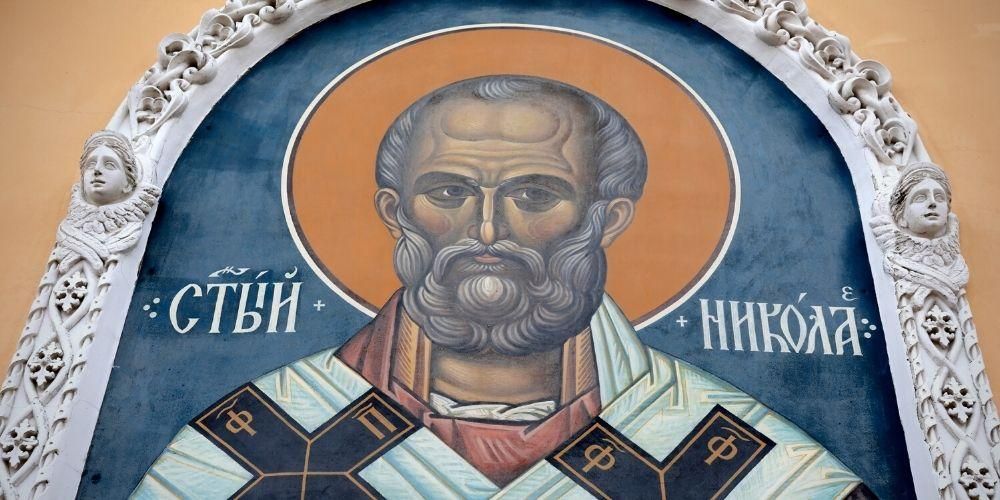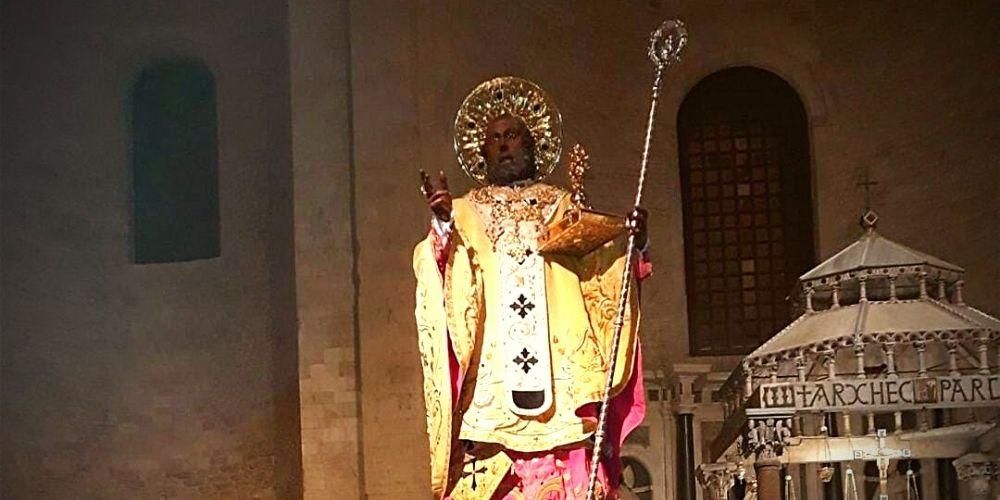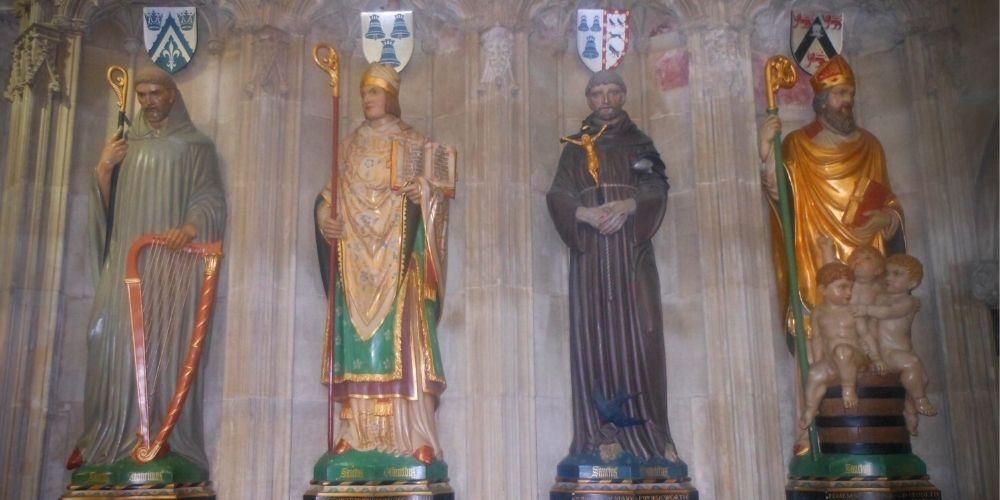Thanks to its distinctive position along the Italian peninsula, the city of Bari has always been a crossroads of different peoples and cultures, a symbol of hospitality in southern Italy, as evidenced by the numerous events that have taken place there and the numerous architectural styles framing it. It is therefore not surprising that its patron saint is the one who best represents the union and fellowship between the West and the East, only seemingly distant worlds: Saint Nicholas.
Fiercely worshipped throughout the world, especially by the Orthodox believers, with the approval of the Orthodox Church, the ‘saint of the people’ is celebrated every year on the 6th of December. This date officially marks the beginning of the Christmas celebrations for the people of Bari. Tradition involves the celebration of a mass at the basilica of the same name at dawn, followed by a visit to the crypt that houses his relics, an evocative torchlight procession, and the ever-present breakfast with hot chocolate in the narrow streets of the old town.
Want to know more about it? That's the right place! Keep reading to find out everything you need to know about the Feast of Saint Nicholas of Bari, a ritual that will be repeated in 2025, and how to make the most of it if you're around there.

Feast of St. Nicholas of Bari: the history

But what does Saint Nicholas have to do with the East and the Orthodox Church? Actually, not everyone knows that the saint, who lived between the third and fourth centuries, did not come from Bari at all. His birthplace was in fact Patara, Turkey, and he was well-known for being the bishop of the town of Myra, protector of children, women seeking husbands, and sailors, as well as a giver of gifts, healings, and miracles.
The bishop's relationship with Bari actually began many years later, at the end of the 11th century. His relics were stolen in 1087 by 62 Norman sailors from Bari and taken to the city, now the capital of Apulia, which at the time had just been conquered after the defeat of the Byzantines. In the same year, work began on the basilica dedicated to him, which was completed about a century later and is still one of the symbols of the city, a landmark in Bari Vecchia and home to the crypt containing the relics.
The bones translation, celebrated during the patron saint's feast day in May, is certainly an ungracious gesture, but it has marked the history of Bari and the Christian religion, lifting the city out of economic crisis and representing a link between different faiths.
Saint Nicholas and faith: the holy Mass at the basilica at dawn

A saying from Bari goes: “Sanda Necol' jè amand' d' l' frastir', ma l' baris ten' semb' jind' o cor' e penzir”; meaning “Saint Nicholas loves strangers, but always carries the people of Bari in his heart and thoughts.” This phrase echoes in a renewed spirit at the dawn of December 6, the day when the city celebrates its patron saint and officially kicks off the Christmas season - not surprisingly, Saint Nicholas is associated with Santa Claus. And now it's time to dive into the heart of the celebration.
The program of celebrations has been confirmed for 2025: the day begins very early, with the celebration of solemn mass at the first light of the 6th if December, around 5 a.m. The atmosphere is truly magical: the doors of the basilica in Bari Vecchia open to the public during the night and the streets come alive with the warmth and buzz of the many faithful who, punctual as every year, do not miss the date; an experience enclosed in a wonderful setting of Christmas lights and decorations, where the scent of breakfast permeates the air as the citizens wake up.
The next stop is the traditional visit to the crypt of St. Nicholas in the basement of the basilica, where the saint's spoils and other relics are kept, which are particularly important for Orthodox believers. One of the most interesting and evocative religious objects inside, both for religious figures and popular culture, is the so-called miraculous column. Made of reddish marble, according to legend it was found on the seashore on the night between September 30 and October 1, 1089, the day the bones were laid to rest in the newly built crypt. It seems that it had come from Constantinople or Myra itself, brought by the saint himself, but no one was able to transport it. It was therefore Nicholas himself who installed it as the base for the construction of his basilica.
But why is it considered miraculous? The ancient folk ritual of the maidens reveals the mystery. It is an ancient tradition deeply rooted in local culture: unmarried women of a certain age would ask the saint for a favor by touching the surface of the column and circling it three times in a row. It is probably just a legend, but many testimonies swear that they found their soul mate. Today, however, this popular custom has been abandoned because, for reasons of safety and heritage protection, the column is protected by a solid metal cage. Nevertheless, the most devoted believers still leave personal notes at the foot of the marble pillar.
Visit the famous Basilica of St. Nicholas in BariSaint Nicholas and tradition: the torchlight procession and the hot chocolate
While Mass is celebrated within the walls of the historic center, a traditional spectacle takes shape in the main streets of the city: the torchlight procession of St. Nicholas. The most energetic of the faithful march to commemorate the saint in a more dynamic way, lighting up the city with bright torches. The procession starts from Parco 2 Giugno, in the heart of the city, and ends at the Basilica: a true city pilgrimage in honor of the patron saint.
But what would the Feast of St. Nicholas be without a sweet surprise? Once again this year, the gastronomic tradition of December 6 in Bari, at the end of Mass and the arrival of the marathon runners, includes the most expected moment, especially for children: the traditional breakfast based on hot chocolate. It will be served to visitors by the inhabitants of the Old Town, together with typical Apulian Christmas sweets and some of local street foods, such as sgagliozze and popizze.
The festive day continues until evening and includes the ritual lighting of the Christmas tree in Piazza del Ferrarese, which unmistakably marks the approach of Christmas. And as always, for many people in Bari, this is also the perfect time to decorate their homes and celebrate with panzerotti!
The cult of St. Nicholas around the world

It is no coincidence that today Saint Nicholas is the most venerated saint in the world and his figure has been superimposed on some typical characters from folklore: Grandfather Frost in Eastern Europe, Father Winter in Germanic countries, Sinterklaas in Netherlands - all alter egos of the much more famous Santa Claus, a contraction of Saint Nicolaus, a name derived from the emigration of European faithful to America.
Over time, many churches dedicated to the saint have been built around the world, both Catholic and Orthodox: the cult of Nicholas spread especially in Russia and Eastern Europe (Greece, Bohemia, Turkey), Western Europe (the Netherlands, Flanders, Germany, and England), Northern Europe (Denmark and Iceland), and North America.
A special case is the church in New York, marked by a tragic past: it was located next to the World Trade Center and unfortunately it was destroyed by the terrorist attacks of September 11, 2001. It was subsequently rebuilt, and its official website immediately displays the hashtag #rebuildmychurch, a message that aims to send a message of peace, hope, and resilience.
Feast of Saint Nicholas of Bari 2025: experiencing tradition to the fullest
Beloved by both Catholics and Orthodox Christians, Saint Nicholas is known, as we have seen, as “the saint of the people.” His ability to join two religious beliefs is comparable to that of bringing citizens together in a symbolic embrace to celebrate the festivities and revive the traditions we have just listed.
Beyond religious issues, the Feast of St. Nicholas, with the “secular” rituals it has given rise to over the centuries, has had the merit of recreating an unmissable event that is renewed annually and is eagerly awaited and loved by the community of Bari, which can joyfully walk towards Christmas.
For the 2025 festivities, the mass, visit to the crypt, torchlight procession, and breakfast will take place in the Apulian capital as usual and may represent a unique opportunity to visit the city and experience its authentic spirit in the run-up to the most wonderful time of the year: so why not consider a little trip on this magical night?
About the author
Written on 20/10/2022



Massimiliano Antonio Primi
Solemn functions and popular traditions set the scene for Christmas in Bari on December 6th dawn celebrating Nicholas, the 'saint of all people'.